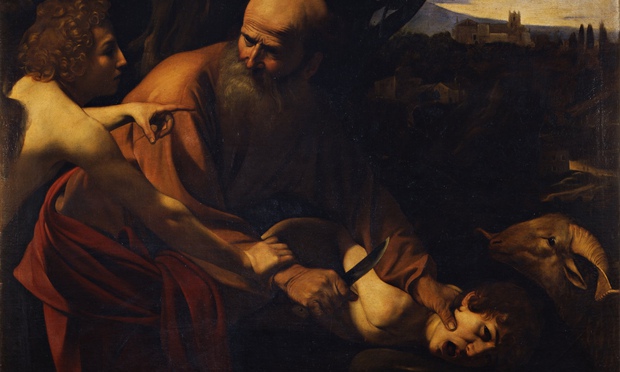Has the Bible gone from hot to not in the art world?
New York’s Museum of Biblical Art is about to close down. What a shame: religious art may not attract wealthy donors, but the Bible has always been – and remains – a powerful trigger for artistic expression

Extreme and provocative … Caravaggio’s The Sacrifice of Isaac (1603-04). Photograph: Fine Art Images/Heritage Images/Getty Images
Is the Bible hot? It is not – at least in the art world.
New York’s Museum of Biblical Art has announced that it is closing, despite a big success with its latest – its last – exhibition about the great Florentine artist Donatello.
The reasons for the closure include a need to move to a new building, which the short-lived institution has discovered it cannot afford. But clearly, there’s something about a museum of biblical art that has failed to attract wealthy donors and the kind of cultural credibility that brings in sponsorship.
It sounds more Bible belt than Manhattan – for surely only fundamentalists and religious conservatives are interested in seeing art through a biblical lens. Right?
That is a terrible misunderstanding, and this museum’s closure a great shame. For, whatever your beliefs or lack of them, there is no doubt the Bible has played a huge part in the story of art – and still does.
If you think religious imagery has no place in modern art, consider Barnett Newman’s paintings Adam and Eve. Newman translates the Bible’s first man and woman into red vertical columns in fields of purple-brown: the nude portrayals of these inhabitants of Eden by earlier artists such as Albrecht Dürer become lines of stark abstraction. This is not the only echo of Genesis in Newman’s art. His entire aesthetic of sublime power suggests God giving the 10 commandments to Moses or dividing the waters from the earth. Newman’s Broken Obelisk might be an image of the destruction of the temple or the fall of Babylon. In his cycle of shockingly austere paintings The Stations of the Cross, he turns to the New Testament story of the Passion.
Barnett Newman proved that the Bible can still animate modern art, and this is no surprise given that artists in history have so often interpreted biblical stories in daring ways. Caravaggio’s painting The Sacrifice of Isaac shows how extreme and provocative biblical art can be: as Abraham prepares to kill his son with a knife he holds down the boy’s head brutally. This is no willing sacrifice. Isaac looks out, terrified. Similarly stupendous is Rembrandt’s depiction of the Three Crosses, as tragic and forbidding as an abstract expressionist painting.
The Bible has often been a source of surprisingly heterodox and subversive art. Artemisia Gentileschi was able to fill the story of Judith, who slew Holofernes, enemy of the Israelites, with feminist meaning several centuries before feminism. Sandro Botticelli saw signs of social revolution in the Bible’s book of Revelation. As for Hieronymous Bosch, he transfigured Christian art into something utterly strange and inexplicable.
No wonder the Bible still lives in art. Newman is far from the only modern artist to draw on it. Salvador Dalí painted a mystical Christ of Saint John of the Cross that rivals the great Christian artists of 17th-century Spain. Pier Paolo Pasolini’s film The Gospel According to Saint Matthew is one of the greatest of all filmed artworks. Andy Warhol, with strange premonition, created a moving series of pictures of The Last Supper shortly before he died.
Today, the video artist Bill Viola meditates eerily and memorably on Christian faith.
There seems to be no end to the creativity the Bible engenders – which makes it a crying shame the Museum of Biblical Art has to close, and a tragedy if we cannot acknowledge one of the great sources of modern culture.
By Jonathan Jones
Source: http://www.theguardian.com